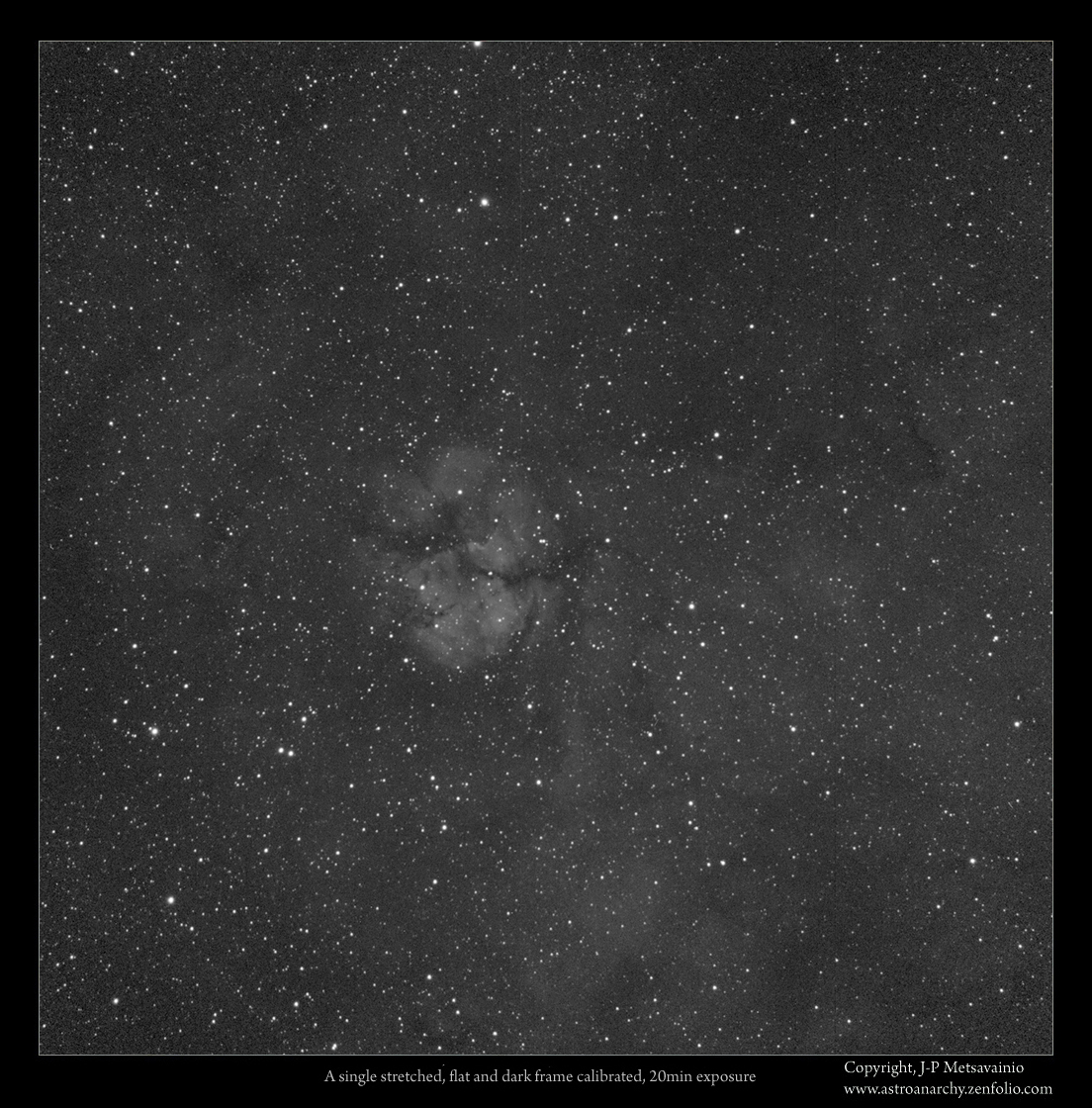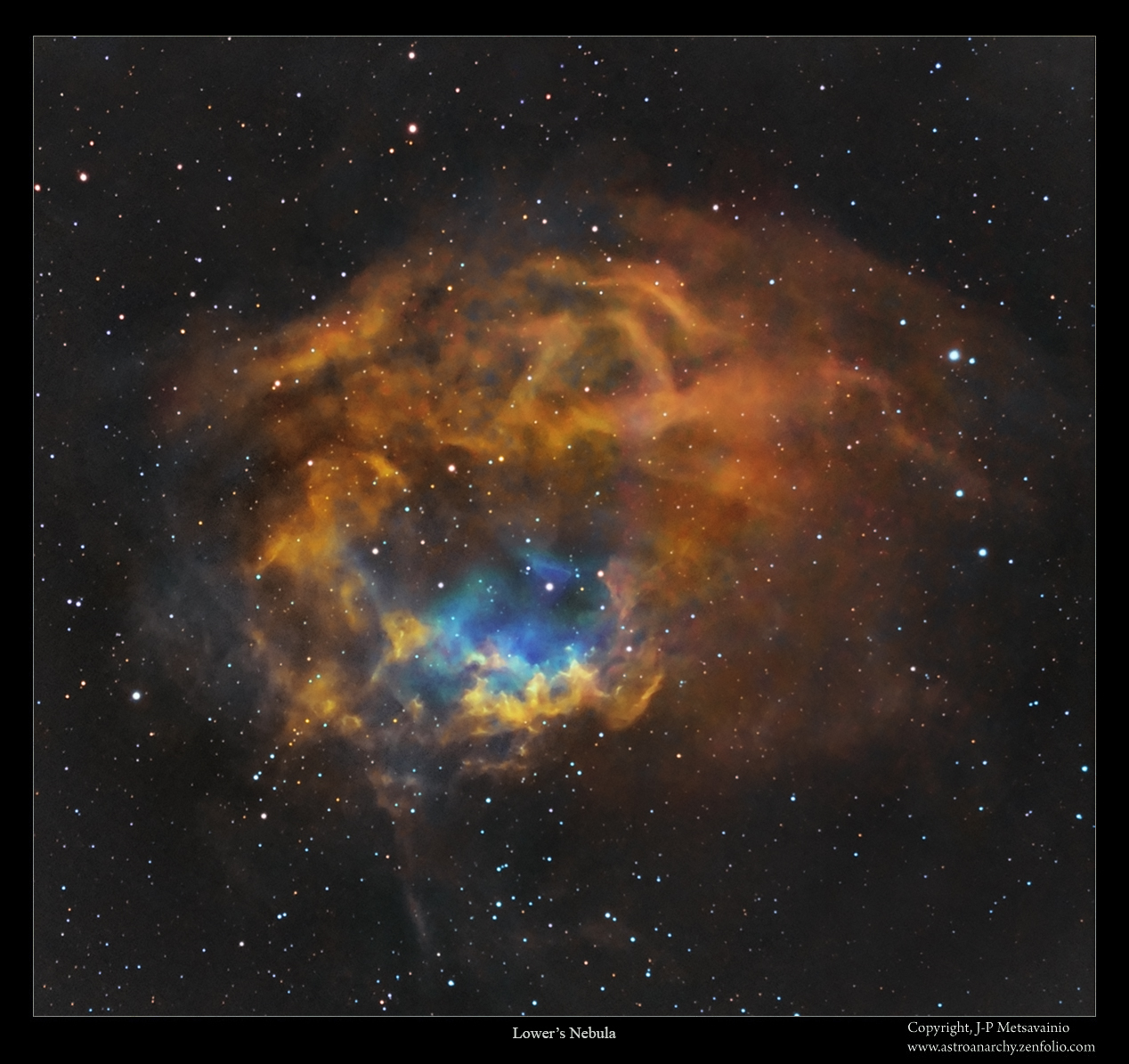COPYRIGHT, PLEASE NOTE
All the material on this website is copyrighted to J-P Metsavainio, if not otherwise stated. Any content on this website may not be reproduced without the author’s permission.
BUY A MUSEUM QUALITY POSTER
BUY A POSTER:https://astroanarchy.zenfolio.com/
Thursday, March 31, 2016
The Lower's nebula in visual colors
I have published a photo of the Lower's Nebula in mapped colors about a week ago. Now I'm publishing the same nebula as a visual natural color version. Narrowband emission from hydrogen, oxygen and sulfur (H-a, O-III and S-II) are combined so, that the result is very close to a visual spectrum. Since the ionized hydrogen emits red light and it usually dominates nebulae, images are more or less red. Blueish hues are from ionized oxygen, O-III. Sulfur, S-II, emits red too and it get mixed to a hydrogen emission visually.
Lower's Nebula
Click for a large image
Image is in natural colors from the light emitted by an ionized elements, sulfur, hydrogen and oxygen.
INFO
The Sh2-261 (Sharpless 261), also known as the Lower's Nebula, is a faint region of doubly ionized hydrogen. Its apparent dimension is about 50 arcminutes in East-West direction and 30 arcminutes in North-South. So, it has an apparent size about twice the full Moon diameter. Of course the real size of the nebula is much larger! But we have no information about the distance of this hydrogen cloud, so we are not able to determine how large it is. (Source, www.skyfactory.org)
Technical details
Processing work flow
Image acquisition, MaxiDL v5.07.
Stacked and calibrated in CCDStack2.
Deconvolution with a CCDStack2 Positive Constraint, 21 iterations, added at 25% weight
Color combine in PS CS3
Levels and curves in PS CS3.
Imaging optics
Celestron Edge HD 1100 @ f7 with 0,7 focal reducer for Edge HD 1100 telescope
Mount
10-micron 1000
Cameras and filters
Imaging camera Apogee Alta U16 and Apogee seven slot filter wheel
Guider camera, Lodestar x2 and SXV-AOL
Astrodon filter, 5nm H-alpha
Astrodon filter, 3nm O-III
Astrodon filter, 3nm S-II
Exposure times
H-alpha, 9 x 1200s =3h
O-III, 3 x 1200s binned = 1h
S-II, 3 x 1200s binned = 1h
Total 5h
A single uncropped, calibrated and stretched 20 min. H-alpha frame as it comes from the camera

Labels:
Narrowband color images,
nebula
Wednesday, March 30, 2016
Supernova remnant Sharpless 224 in auriga
The imaging season up here 65N starts to be over soon, in a week we'll be out of astronomical darkness for about six months. This photo of dim supernova remnant in constellation Auriga is one of the last images for the Spring season 2016.
Sharpless 224 in visual colorsClick for a large image
Natural color composition from the emission of ionized elements, R=80%Hydrogen+20%Sulfur, G=100%Oxygen and B=85%Oxygen+15%Hydrogen to compensate otherwise missing H-beta emission. This composition is very close to a visual spectrum.
Click for a large image
The photo is in mapped colors from the light emitted by an ionized elements,
red=sulfur, green=hydrogen and blue=oxygen.
INFO
Supernova remnant Sharpless 224, Sh2-224, locates in constellation Auriga at distance of about 14700 light years. It has an apparent size about 60 arc minutes, the real size is around 235 light years. This is a very dim target and lots of exposure time is needed to reveal any details out of it. Beside Hydrogen alpha, there are also weak emission from ionized oxygen, O-III, and ionized sulfur, S-II.
Wide field images of the area
Click for a large photo, 1800 x 1500 pixels, 3MB
This photo is from March 2009. QHY9 astrocamera, Canon EF 200mm f1.8 camera lens and Baader narrowband filters. Total exposure time is around 15h. Original photo with technical details can be seen HERE
12 panel mosaic of constellation Auriga
Click for a large photo, 2600 x 1200 pixels, 5MB
Mosaic image is from March 2012. This panoramic mosaic spans about 21 degrees of sky.
That's 42 full Moons side by side. QHY9 astrocamera, Canon EF 200mm f1.8 camera lens and Baader narrowband filters. Total exposure time is around 70h. Original photo with technical details can be seen HERE
Technical details
Processing work flow
Image acquisition, MaxiDL v5.07.
Stacked and calibrated in CCDStack2.
Deconvolution with a CCDStack2 Positive Constraint, 21 iterations, added at 25% weight
Color combine in PS CS3
Levels and curves in PS CS3.
Imaging optics
Celestron Edge HD 1100 @ f7 with 0,7 focal reducer for Edge HD 1100 telescope
Canon EF 200mm f1.8 camera optics (For S-II and O-III channels)
Mount
10-micron 1000
Meade LX200 GPS 12" (For S-II and O-III channels)
Cameras and filters
Imaging camera Apogee Alta U16 and Apogee seven slot filter wheel
Guider camera, Lodestar x2 and SXV-AOL
QHY9 (For S-II and O-III channels)
QHY9 (For S-II and O-III channels)
Astrodon filter, 5 nm H-alpha
Baader filter, 8,5 nm O-III
Baader filter, 8 nm S-II
Exposure times
H-alpha, 24 x 1200s binned 2x2 =8h
O-III, 12 x 600s binned 4x4 = 2h (Year 2009)
S-II, 12 x 600s binned 4x4 = 2h (Year 2009)
Total 12h
A single uncropped, calibrated and stretched 20 min. H-alpha frame as it comes from the camera
Labels:
Narrowband color images,
nebula
Saturday, March 26, 2016
A new photo, Sharpless 124, an emission nebula in constellation Cygnus
I shot the lights for this target at January 6. 2016 The data wasn't very good due to weak transparency and a poor seeing at the time. I got this processed just now and the result is much better, than I thought it might be.
There are very few photos and scientific information out of this rarely imaged target. It locates in constellation Cygnus at estimated distance of 8400 light years. Total exposure time for my photo is only seven hours. I will continue with this target at next Autumn, hopefully with better atmospheric conditions.
Sharpless 124, Sh2-124
Ra 21 38 17 Dec +50 19 48
The photo is in mapped colors from the light emitted by an ionized elements,
red=sulfur, green=hydrogen and blue=oxygen.
Sharpless 124 in visual colors
Natural color composition from the emission of ionized elements, R=80%Hydrogen+20%Sulfur, G=100%Oxygen and B=85%Oxygen+15%Hydrogen to compensate otherwise missing H-beta emission. This composition is very close to a visual spectrum.
Sharpless 124, in H-alpha emission only
Technical details
Processing work flow
Image acquisition, MaxiDL v5.07.
Stacked and calibrated in CCDStack2.
Deconvolution with a CCDStack2 Positive Constraint, 21 iterations, added at 25% weight
Color combine in PS CS3
Levels and curves in PS CS3.
Imaging optics
Celestron Edge HD 1100 @ f7 with 0,7 focal reducer for Edge HD 1100 telescope
Mount
10-micron 1000
Cameras and filters
Imaging camera Apogee Alta U16 and Apogee seven slot filter wheel
Guider camera, Lodestar x2 and SXV-AOL
Astrodon filter, 5nm H-alpha
Astrodon filter, 3nm O-III
Astrodon filter, 3nm S-II
Exposure times
H-alpha, 15 x 1200s =5h
O-III, 3 x 1200s binned = 2h
S-II, 3 x 1200s binned = 2h
Total 7h
A single uncropped, calibrated and stretched 20 min. H-alpha frame as it comes from the camera
H-alpha data was binned 2x2
Labels:
Narrowband color images,
nebula
Thursday, March 24, 2016
A new image, the Lower's nebula
We now have had few clear nights after having a solid cloud cover for over two months. Transparency and seeing were poor at most of the time though. I managed to collect some data for two imaging projects. The Lower's Nebula was the first one. This is a dim and rarely imaged emission nebula in constellation Orion. There are not too many photos out of this one and it was difficult to collect information about it. Total exposure time is only 5h, I will continue this project at spring season 2017.
Lower's Nebula
red=sulfur, green=hydrogen and blue=oxygen.INFO
The Sh2-261 (Sharpless 261), also known as the Lower's Nebula, is a faint region of doubly ionized hydrogen. Its apparent dimension is about 50 arcminutes in East-West direction and 30 arcminutes in North-South. So, it has an apparent size about twice the full Moon diameter. Of course the real size of the nebula is much larger! But we have no information about the distance of this hydrogen cloud, so we are not able to determine how large it is. (Source, www.skyfactory.org)
Technical details
Processing work flow
Image acquisition, MaxiDL v5.07.
Stacked and calibrated in CCDStack2.
Deconvolution with a CCDStack2 Positive Constraint, 21 iterations, added at 25% weight
Color combine in PS CS3
Levels and curves in PS CS3.
Imaging optics
Celestron Edge HD 1100 @ f7 with 0,7 focal reducer for Edge HD 1100 telescope
Mount
10-micron 1000
Cameras and filters
Imaging camera Apogee Alta U16 and Apogee seven slot filter wheel
Guider camera, Lodestar x2 and SXV-AOL
Astrodon filter, 5nm H-alpha
Astrodon filter, 3nm O-III
Astrodon filter, 3nm S-II
Exposure times
H-alpha, 9 x 1200s =3h
O-III, 3 x 1200s binned = 1h
S-II, 3 x 1200s binned = 1h
Total 5h
A single uncropped, calibrated and stretched 20 min. H-alpha frame as it comes from the camera
Labels:
Narrowband color images,
nebula
Subscribe to:
Comments (Atom)




















